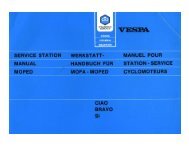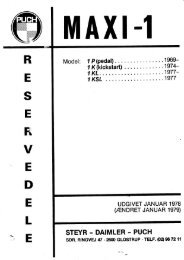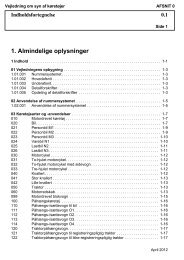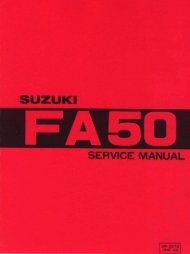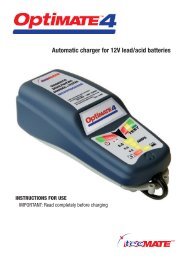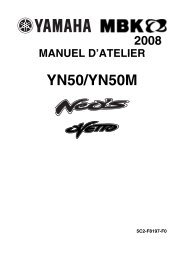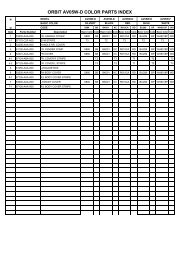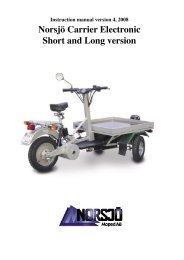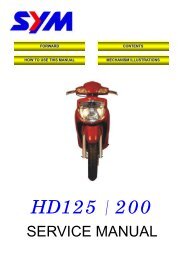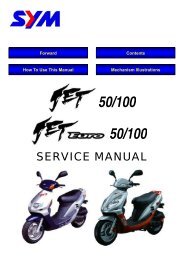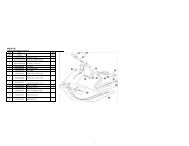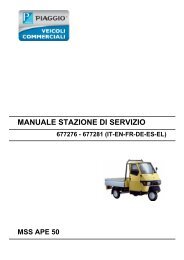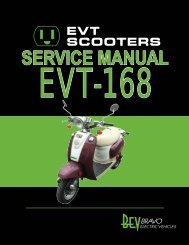Advanced Electronic Fuel Injection Systems - Scootergrisen
Advanced Electronic Fuel Injection Systems - Scootergrisen
Advanced Electronic Fuel Injection Systems - Scootergrisen
Create successful ePaper yourself
Turn your PDF publications into a flip-book with our unique Google optimized e-Paper software.
2001-01-0010<br />
<strong>Advanced</strong> <strong>Electronic</strong> <strong>Fuel</strong> <strong>Injection</strong> <strong>Systems</strong> –<br />
An Emissions Solution for both 2- and 4-stroke<br />
Small Vehicle Engines<br />
ABSTRACT<br />
This paper describes two advanced electronic fuel<br />
injection systems for small vehicles which have recently<br />
become commercially available. Both systems have been<br />
designed and developed by the authors’ organisation.<br />
One of the two systems (‘aSDI’) has been<br />
designed and developed for 2-stroke engines and the other<br />
(‘SePI’) for 4-stroke engines. Both systems are intended<br />
for application on small vehicles fitted with small 1 – 2<br />
cylinder gasoline engines of displacement 50 – 250 cm 3<br />
per cylinder. Typical examples of such small vehicles<br />
are: ATV’s (All Terrain Vehicles), auto-rickshaws,<br />
motorcycles, motorscooters and mopeds 1 .<br />
<strong>Fuel</strong> consumption and emissions results from<br />
both systems are presented, and in both cases it is<br />
shown that engine-out exhaust emissions meet current<br />
and future limits in Europe, India and Taiwan, without the<br />
need for exhaust after-treatment. It is also shown that<br />
both systems offer significant fuel savings relative to<br />
otherwise-equivalent, carburetted baseline vehicles.<br />
Other important benefits of these systems which<br />
are discussed in this paper are improved cold start and<br />
improved driveability.<br />
The paper also includes a short overview of the<br />
performance and cost implications of both systems<br />
relative to alternative emissions control methods.<br />
1 For reasons of convenience, these types of vehicles will<br />
be referred to collectively as ‘small vehicles’ in this paper.<br />
Mark Archer, Greg Bell<br />
Synerject <strong>Systems</strong> Integration, Balcatta, Australia<br />
1. INTRODUCTION<br />
During the last 30 years or so, reductions in<br />
tailpipe exhaust emissions of more than 90% have been<br />
demanded of, and achieved by the automobile industry<br />
[1], with one of the most important enabling technologies<br />
being low-cost, series-production EFI (<strong>Electronic</strong> <strong>Fuel</strong><br />
<strong>Injection</strong>).<br />
Relative to carburetted fuel systems, the main<br />
mechanisms by which EFI has helped to reduce exhaust<br />
emissions are as follows:<br />
1) Reduced wall wetting.<br />
2) Improved fuel atomisation.<br />
3) Greater flexibility in A/F (Air/<strong>Fuel</strong> ratio) control, which<br />
in turn has facilitated:<br />
• Improved warm - and cold-start emissions.<br />
• Reduced transient emissions.<br />
• Increased lean A/F operation.<br />
• High conversion-efficiency exhaust aftertreatment.<br />
4) Improved unit-to-unit repeatability.<br />
In addition to reduced exhaust emissions, EFI<br />
has also introduced other benefits such as reduced brakespecific<br />
fuel consumption, increased full-load output and<br />
improved driveability [2].<br />
As a result of this reduction in automobile<br />
exhaust emissions, it is now often smaller vehicles such<br />
as auto-rickshaws, motorcycles, motorscooters and<br />
mopeds which are becoming responsible for an<br />
increasingly significant proportion of the HC (unburnt<br />
hydrocarbons) and CO (carbon monoxide) exhaust<br />
FINAL MANUSCRIPT Page 1 of 22 SIAT26.doc – MDA / GBB – 28/06/01
emissions burden in some urban environments. In the EU<br />
for example, two- and three-wheeled motor vehicles are<br />
currently believed to be responsible for around 5 – 10% of<br />
overall HC and CO emissions, and it is anticipated that<br />
this proportion will increase to 15 – 20% by the year 2020<br />
[3].<br />
In some large Asian cities, the situation is<br />
already more serious; the high popularity of motorcycles<br />
in Taiwan for example, means that they are currently<br />
believed to be responsible for approximately 30% of overall<br />
HC and 40% of overall CO emissions [4].<br />
Increased attention is therefore now being paid to<br />
reducing exhaust emissions from small vehicles, and one<br />
obvious means of achieving such a reduction is to apply<br />
EFI technology from the automotive sector.<br />
When considering the small vehicle market<br />
relative to the automobile market however, one key<br />
difference immediately becomes apparent; namely: cost.<br />
This ‘cost’ issue manifests itself in two very important<br />
ways as follows:<br />
1) In the small vehicle market, the maximum allowable<br />
piece cost of an emissions reduction system, is<br />
smaller than in the automobile market (by<br />
approximately one order of magnitude).<br />
2) The incremental investment cost of a new technology<br />
which will be tolerated by the small vehicle industry is<br />
also much smaller than in the automobile industry.<br />
The need for cost-effective emissions solutions in<br />
the small vehicle industry is therefore widely recognised,<br />
and, as outlined in the following section, a number of<br />
alternative low-cost strategies are currently being pursued.<br />
The strategy detailed in this paper involves the<br />
application of advanced electronic injection systems:<br />
Direct-Injected (DI) in the case of 2-stroke engines and<br />
Port-Injected (PI) in the case of 4-stroke engines.<br />
Although higher in piece cost than some alternative<br />
systems, we believe that such systems offer a better<br />
overall cost / benefit balance (i.e. when piece cost,<br />
production cost, operational, reliability, environmental, and<br />
other issues are all taken into account).<br />
The aims of this paper are therefore:<br />
1) To provide a brief description of the Synerject 2-stroke<br />
and 4-stroke fuel injection systems.<br />
2) To present test results and other information which<br />
help give a better understanding of the overall cost /<br />
benefit balance offered by both systems.<br />
The 2-stroke system described in this paper<br />
became available to the public for the first time in June<br />
2000 on the Aprilia ‘DITECH’ SR 50 motorscooter (Figure<br />
1) and will soon appear on a number of other small vehicle<br />
models produced by a variety of manufacturers worldwide.<br />
Public response to the Aprilia DITECH SR50<br />
motorscooter has been very positive with most significant<br />
operating benefits being [5]:<br />
• ‘Real world’ fuel consumption benefit of 40%.<br />
• Negligible exhaust smoke emissions.<br />
• Improved cold-start.<br />
• Improved driveability.<br />
• Oil consumption reduced by more than 50%.<br />
• Oil ‘top-up’ service interval increased to 4,000 km.<br />
Figure 1 - Aprilia DITECH SR50 motorscooter<br />
The 4-stroke system described in this paper is<br />
due to be released to the public in 2001.<br />
2. ALTERNATIVE EMISSIONS REDUCTION<br />
METHODS FOR SMALL VEHICLES<br />
This section includes a brief description of the<br />
main emissions reduction methods currently being used<br />
and/or considered for use by the small vehicle industry.<br />
The advantages and disadvantages associated with these<br />
various emissions reduction methods are summarised in<br />
Table 1 and Table 2. These methods are as follows:<br />
FINAL MANUSCRIPT Page 2 of 22 SIAT26.doc – MDA / GBB – 28/06/01
Table 1 – Comparison of different emissions control systems for small vehicle 2-stroke engines<br />
Attribute<br />
System<br />
2-stroke carburettor<br />
(Baseline):<br />
Oxidation catalyst:<br />
Replace with<br />
4-stroke:<br />
2-stroke electronic<br />
injection (‘aSDI’):<br />
‘aSDI’ + oxidation<br />
catalyst:<br />
<strong>Fuel</strong> consumption<br />
& CO2 emissions<br />
CO emissions<br />
HC + NOx emissions<br />
Emissions durability<br />
(catalyst aging / misfire)<br />
Specific torque & power<br />
(Acceleration)<br />
Cold start<br />
FINAL MANUSCRIPT Page 3 of 22 SIAT26.doc – MDA / GBB – 28/06/01<br />
Driveability<br />
Maintenance<br />
(Oil / oil filter servicing)<br />
Incremental piece cost *<br />
– relative<br />
Incremental investment cost<br />
* – relative<br />
( = ) ( = ) ( = ) ( = ) ( = ) ( = ) ( = ) ( = ) 0.0 0.0 ✖✖ Much worse<br />
= ✓ ✓ ✖ ✖ = = = 0.3 0.5 ✖ Worse<br />
✓ ✖ ✓ ✓ ✖✖ = ✓ ✖ 1.0 2.0 = Equal<br />
✓✓ ✓ ✓ ✓ = ✓ ✓✓ ✓ 1.0 1.0 ✓ Better<br />
✓✓ ✓✓ ✓✓ ✓ = ✓ ✓✓ ✓ 1.3 1.5 ✓✓ Much better<br />
* Indicative cost increment only for 10,000 units per annum – actual costs vary significantly from market to market<br />
Data sources: [3], [5], [6] & [7] plus internal cost estimates<br />
Table 2 - Comparison of different emissions control systems for small vehicle 4-stroke engines<br />
Attribute<br />
System<br />
4-stroke carburettor<br />
(Baseline):<br />
SAI (Secondary Air<br />
<strong>Injection</strong>):<br />
SAI + oxidation<br />
catalyst:<br />
4-stroke electronic<br />
injection (‘SePI’):<br />
‘SePI’ + Three-Way<br />
Catalyst (TWC):<br />
<strong>Fuel</strong> consumption<br />
& CO2 emissions<br />
CO emissions<br />
HC + NOx emissions<br />
Emissions durability<br />
(cat. aging / tampering)<br />
Specific torque & power<br />
(Acceleration)<br />
Cold start<br />
Driveability<br />
Maintenance<br />
(SAI valve inspect/clean)<br />
Incremental piece cost *<br />
– relative<br />
Incremental investment cost<br />
* – relative<br />
( = ) ( = ) ( = ) ( = ) ( = ) ( = ) ( = ) ( = ) 0.0 0.0 ✖✖ Much worse<br />
= ✓ ✓ ✖ = = = ✖ 0.5 1.0 ✖ Worse<br />
= ✓✓ ✓✓ ✖ = = = ✖ 0.8 1.5 = Equal<br />
✓ ✓ ✓ ✓ ✓ ✓ ✓ = 1.0 1.0 ✓ Better<br />
✓ ✓✓ ✓✓ ✓ ✓ ✓ ✓ = 1.3 1.5 ✓✓ Much better<br />
* Indicative cost increment only for 10,000 units per annum – actual costs vary significantly from market to market<br />
Data sources: [3] & [6] plus internal cost estimates<br />
Key<br />
Key
2.1 SUBSTITUTE CARBURETTED 4-STROKE<br />
ENGINES FOR CARBURETTED 2-STROKE<br />
ENGINES.<br />
Relative to carburetted 2-stroke engines, the main benefits<br />
offered by carburetted 4-stroke engines are:<br />
• Misfire-free operation.<br />
• Reduced fuel consumption and CO 2 emissions.<br />
• Reduced HC emissions.<br />
• Improved driveability<br />
However, this is a relatively high piece and<br />
investment cost strategy, which is sometimes driven more<br />
by the ‘clean’ image of 4-strokes relative to 2-strokes,<br />
rather than an objective consideration of state-of-the-art 2stroke<br />
and 4-stroke engine performance per se.<br />
While this ‘substitution’ strategy successfully<br />
eliminates the high levels of HC, smoke and odour<br />
emissions typically associated with carburetted 2-stroke<br />
engines, the engine-out CO and NOx (Nitrogen Oxide)<br />
emissions are usually higher, and because of the<br />
difference in specific output between 2-stroke and 4-stroke<br />
engines, a larger, heavier and more expensive ‘substitute’<br />
4-stroke engine is normally required to maintain an<br />
equivalent level of performance.<br />
2.2 FIT EXHAUST AFTER-TREATMENT<br />
CATALYSTS.<br />
Because small vehicles are only responsible for a<br />
relatively low proportion of overall NOx emissions<br />
(estimated to be less than 3% [3] [4]), oxidation-only<br />
catalysts are usually fitted to small vehicle engines. In<br />
the case of 4-stroke engines, these catalysts are used<br />
principally to control CO emissions, while in the case of 2stroke<br />
engines they are used to treat both HC and CO<br />
emissions. The main advantage of this strategy, is that it<br />
is one of the cheaper means of achieving compliance with<br />
current emissions legislation, if the base engine is a<br />
carburetted 2-stroke [3] [6].<br />
Although attractive from the perspective of low<br />
piece and investment cost therefore, catalysts offer no<br />
reduction in fuel consumption or CO 2 emissions, and are<br />
susceptible to deterioration, particularly on carburetted 2strokes<br />
due to the large quantity of unburnt fuel and oil in<br />
the exhaust [8].<br />
Catalyst fitment also increases exhaust<br />
temperature and back-pressure, and, particularly in the<br />
case of 2-stroke engines, peak power output can be<br />
significantly reduced as a result. In the absence of<br />
periodic emissions testing, the effectiveness of this<br />
strategy can also be reduced by tampering (e.g.<br />
intentional modification and/or removal).<br />
The anticipated, widespread introduction of<br />
emissions durability requirements and/or ‘cold-start’<br />
emissions testing will make small vehicle catalyst<br />
durability and ‘light-off’ more important issues than is<br />
currently the case.<br />
2.3 SECONDARY AIR INJECTION (SAI).<br />
This technique is now being increasingly applied<br />
to small vehicle 4-stroke engines as a means to reduce<br />
CO, and to a lesser extent, HC. Usually a ‘passive’ reed<br />
valve system is used; i.e. negative pressure pulses in the<br />
exhaust system are used to draw fresh, filtered air into the<br />
exhaust stream, immediately downstream of the exhaust<br />
valve. The main advantage of this strategy, is that it is<br />
one of the cheaper ways of achieving compliance with<br />
current emissions legislation if the base engine is a<br />
carburetted 4-stroke [3] [6].<br />
Potential problems with such systems include<br />
backfiring [6] and carboning of the reed valve. To ensure<br />
continued system function, periodic inspection and/or<br />
cleaning of the reed valve(s) is usually recommended (for<br />
motorcycles: typically every 5,000 – 6,000 km).<br />
‘Passive’ SAI is not well suited to carburetted 2stroke<br />
engine applications, due to the following reasons:<br />
• 2-stroke engines rely on negative exhaust pressure<br />
pulsations to help scavenge the combustion chamber.<br />
If these pulsations are instead used to draw fresh air<br />
into the exhaust stream, cylinder scavenging (and<br />
thus engine performance) can be compromised.<br />
• On a carburetted 2-stroke engine, unburnt HC are<br />
generated mostly as a result of the intake charge<br />
‘short-circuiting’ to the exhaust port during<br />
scavenging. By definition however, this ‘short -<br />
circuited’ charge will contain both unburnt HC and<br />
unburnt air. As a result, adding extra air to such a<br />
mixture achieves little in it’s own right.<br />
• In the case of ‘combined’ SAI / oxidation catalyst<br />
systems, passive SAI can result in excessive catalyst<br />
temperature with reduced catalyst and muffler<br />
durability as a result [9].<br />
2.4 APPLY ADVANCED ELECTRONIC FUEL<br />
INJECTION SYSTEMS.<br />
This is the strategy advocated by Synerject for<br />
both 2-stroke and 4-stroke engines, and the one which will<br />
be detailed in the remainder of this paper. Although<br />
higher in piece cost than either oxidation catalysts or SAI<br />
systems (refer Table 1 and Table 2), by offering<br />
significantly reduced fuel consumption and increased<br />
riding pleasure in addition to very low engine-out exhaust<br />
emissions, we believe that such systems offer the best of<br />
all worlds to both manufacturer and end user on an overall<br />
cost / benefit basis.<br />
FINAL MANUSCRIPT Page 4 of 22 SIAT26.doc – MDA / GBB – 28/06/01
Of course, certain combinations of the various<br />
methods described above can also be implemented. For<br />
example, both 2-stroke and 4-stroke electronic injection<br />
systems have been successfully combined with exhaust<br />
catalysts, and in the medium term it is anticipated that<br />
such systems will become ‘standard’ as emissions<br />
requirements become more stringent [7]. ‘Combined’ fuel<br />
injection / catalyst and SAI / catalyst systems have<br />
therefore also been included in Table 1 and Table 2, for<br />
comparison purposes.<br />
Note that catalyst fitment has much less effect on<br />
the performance of a DI 2-stroke engine relative to a<br />
carburetted 2-stroke engine; because DI produces far less<br />
engine-out HC and CO emissions, and catalyst<br />
temperature / back-pressure are considerably reduced as<br />
a result.<br />
On small vehicle 4-stroke engines, electronic<br />
injection systems can be combined with an Exhaust Gas<br />
Oxygen (EGO) sensor and Three-Way Catalyst (TWC) to<br />
facilitate simultaneous treatment of HC, CO and NOx<br />
emissions as is currently done in the automobile industry.<br />
3. OVERVIEW – 2-STROKE VS. 4-STROKE SYSTEMS<br />
The 2-stroke and 4-stroke electronic injection<br />
systems presented in this paper are similar in many<br />
respects. Both are intended for fitment to 1 – 2 cylinder<br />
gasoline engines of 50 – 250 cm 3 swept volume, and<br />
consequently share many of the same components.<br />
However, the two systems also differ in a number of<br />
important respects, the most significant difference being<br />
that the 2-stroke system is a DI (Direct <strong>Injection</strong>) system,<br />
whereas the 4-stroke system is a PI (Port <strong>Injection</strong>)<br />
system.<br />
Table 3, Table 4 and Table 5 list the key<br />
components of both systems and schematic diagrams of<br />
both systems are shown on Figure 2 and Figure 3.<br />
Of course, DI can be applied to gasoline 4-stroke<br />
engines also; since 1996 four major auto manufacturers<br />
have released engines of this type to the market, and<br />
many others have indicated that they are developing<br />
engines of this type for near-term market release [10].<br />
The main driver for this change is the reduced fuel<br />
consumption available (typically 10 – 20% better than an<br />
otherwise-equivalent PI 4-stroke engine), in conjunction<br />
with low engine-out NOx [11] [12] . In light of this<br />
development, a logical question is: “Why not apply DI to<br />
small vehicle 4-stroke engines also ?”<br />
Table 3 - Engine management sub-system - key<br />
components<br />
Component ‘aSDI’ ‘SePI’<br />
2-stroke 4-stroke<br />
system system<br />
ECU ✓ ✓<br />
Integrated throttle body /<br />
Throttle Position Sensor<br />
(TPS)<br />
✓ ✓<br />
IAV (Idle Air Valve) ✓<br />
<strong>Electronic</strong> Ignition – High<br />
Energy Inductive (HEI)<br />
coil<br />
✓ ✓<br />
Engine crank sensor ✓ ✓<br />
Engine temperature<br />
sensor<br />
✓ ✓<br />
Vehicle speed sensor Optional Optional<br />
Ambient air pressure<br />
sensor<br />
Optional Optional<br />
Immobiliser Optional Optional<br />
<strong>Electronic</strong> oil pump Optional<br />
‘CO potentiometer’ * Optional Optional<br />
* This function can be carried out by means of a<br />
diagnostic / service tool if required.<br />
(Refer section: ‘Diagnostics and Servicing’ below).<br />
Table 4 - <strong>Fuel</strong> sub-system - key components<br />
Component ‘aSDI’ ‘SePI’<br />
2-stroke 4-stroke<br />
system system<br />
<strong>Fuel</strong> injector ✓ ✓<br />
<strong>Fuel</strong> pump ✓ ✓<br />
<strong>Fuel</strong> regulator ✓ ✓<br />
<strong>Fuel</strong> filter ✓ ✓<br />
Air injector ✓<br />
Air compressor ✓<br />
Air/fuel rail ✓<br />
CVP valve Optional Optional<br />
Table 5 - Combustion sub-system - key components<br />
Component ‘aSDI’<br />
2-stroke<br />
system<br />
Modified cylinder head ✓<br />
Long-projection spark<br />
plug<br />
Modified piston Optional<br />
‘SePI’<br />
4-stroke<br />
system<br />
FINAL MANUSCRIPT Page 5 of 22 SIAT26.doc – MDA / GBB – 28/06/01<br />
✓
Figure 2 - System schematic - 'aSDI' 2-stroke electronic injection<br />
Figure 3 - System schematic - 'SePI' 4-stroke electronic injection<br />
FINAL MANUSCRIPT Page 6 of 22 SIAT26.doc – MDA / GBB – 28/06/01
FINAL MANUSCRIPT Page 7 of 22 SIAT26.doc – MDA / GBB – 28/06/01
In fact, a development of this type does seem<br />
likely in the medium term, as small vehicle fuel<br />
consumption and exhaust emissions continue to assume<br />
still greater importance. In the current small vehicle<br />
market environment however, demand for DI 4-stroke<br />
engines is tempered relative to the automobile market by<br />
the following factors:<br />
1) Increased emphasis on system low cost.<br />
As discussed in the ‘Introduction’ section above.<br />
2) Component availability.<br />
To fully exploit the combined emissions / fuel<br />
consumption benefits offered by DI relative to PI on a<br />
4-stroke engine, the in-cylinder gas/fuel ratio should<br />
be lean, but not unthrottled. On a passenger car<br />
engine, this ‘controlled enleanment’ is readily<br />
achieved by means of an ETB (<strong>Electronic</strong> Throttle<br />
Body) and/or EGR (Exhaust Gas Recirculation).<br />
Although not yet widely available in the small vehicle<br />
industry, such components are standard fitment on<br />
many modern automobiles, and in relative terms, DI 4stroke<br />
application is cheaper and easier as a result.<br />
3) Low demand for reduced engine-out NOx.<br />
Small vehicle emissions legislation in many countries<br />
has been written with the aim of encouraging more<br />
widespread use of 4-stroke engines at the expense of<br />
(carburetted) 2-stroke engines. Because 4-stroke<br />
engines generally produce more NOx than 2-stroke<br />
engines, the emissions legislation ‘push’ towards low<br />
NOx in the small vehicle market is currently weaker<br />
than in the passenger car market, and so there is<br />
little demand to exploit the reduced engine-out NOx<br />
emissions available with DI 4-stroke engines as a<br />
result.<br />
The above arguments explain why PI is currently<br />
preferred to DI for small vehicle 4-stroke engines; so why<br />
not use the same system on small vehicle 2-stroke<br />
engines also?<br />
The short answer to this question is: “cost /<br />
benefit”; on a 2-stroke engine, the cost / benefit offered by<br />
DI is much more favourable than that offered by PI as a<br />
result of the much larger fuel consumption and emissions<br />
benefits available. The main reason for this difference is<br />
that, relative to a carburettor, DI is able to drastically<br />
reduce 2-stroke charge losses during scavenging (to the<br />
point where engine-out HC emissions are on-par with a 4stroke<br />
engine of similar displacement), whereas PI can<br />
only offer a limited improvement (relative to a carburettor)<br />
in this respect.<br />
Because of the fundamentally different cylinder<br />
charge processes of 2-stroke versus 4-stroke engines, DI-<br />
2-stroke fuel systems are also simpler and cheaper than<br />
their 4-stroke counterparts. As demonstrated by the test<br />
results presented in this paper for example, large<br />
improvements in fuel consumption, HC and CO can be<br />
achieved without electronic gasflow control components<br />
(such as ETB’s and/or EGR).<br />
The main benefits offered by PI on a 2-stroke<br />
engine are: reduced fuel consumption (typically by around<br />
10%), improved cold start and improved warm -up;<br />
however, these benefits are available with DI to an even<br />
greater extent.<br />
Because of improved combustion stability, DI 2stroke<br />
NOx emissions are often higher than those from an<br />
otherwise equivalent carburetted (or PI) engine, however,<br />
the NOx emissions from 2-stroke engine are low in any<br />
case, and even on a DI 2-stroke engine, engine-out NOx<br />
emissions are typically:<br />
• Less than the NOx emissions produced by a<br />
carburetted 4-stroke engine of similar displacement.<br />
• Up to an order of magnitude smaller than HC<br />
emissions in massflow terms.<br />
• Well within current and expected legislated limits (see<br />
below).<br />
4. SYSTEM DESCRIPTION – 2-STROKE SYSTEM<br />
(‘aSDI’)<br />
A schematic diagram of the DI 2-stroke system,<br />
known as ‘aSDI’ (air-assisted Synerject Direct <strong>Injection</strong>),<br />
is shown on Figure 2 above. This system is based on the<br />
well-known, air-assisted, direct-injection Orbital<br />
Combustion Process (OCP), which was first released to<br />
the general public in 1996 [13] [14], and has since been<br />
applied to a number of engines in a variety of markets<br />
worldwide.<br />
Key features of OCP are:<br />
• The use of low-pressure compressed air (as opposed<br />
to high fuel pressure) to achieve fuel atomisation.<br />
• The ability to generate an in-cylinder air/fuel ‘cloud’<br />
consisting of very fine droplets.<br />
• High tolerance to in-cylinder ‘residuals’ (i.e. retained<br />
exhaust gas), by virtue of the injected air.<br />
• Separation of fuel metering and in-cylinder injection<br />
functions; these are performed by the fuel injector and<br />
‘air injector’ respectively (refer Figure 4). This ‘division<br />
of responsibilities’ facilitates a number of important<br />
performance benefits including: increased fuel cloud<br />
shaping flexibility, greater deposit immunity and<br />
reduced system cost.<br />
FINAL MANUSCRIPT Page 8 of 22 SIAT26.doc – MDA / GBB – 28/06/01
Figure 4 - OCP fuel and air injectors – typical<br />
arrangement<br />
<strong>Fuel</strong><br />
Compressed air<br />
Direct-injected,<br />
pre-mixed charge<br />
In order to further reduce system cost however,<br />
the ‘aSDI’ system has been significantly simplified relative<br />
to the OCP systems currently used on other series -<br />
production 2-stroke applications [13]. Key changes in<br />
this respect are:<br />
1) The ‘aSDI’ air compressor is run directly off an<br />
eccentric on the crankshaft (Figure 5); other<br />
applications on larger engines typically use a belt- or<br />
gear-driven compressor.<br />
Figure 5 – ‘Direct acting’ compressor drive<br />
Air compressor<br />
Crank web<br />
<strong>Fuel</strong><br />
injector<br />
Machined<br />
eccentric<br />
Air/fuel rail<br />
Air<br />
injector<br />
Crankshaft<br />
Piston<br />
2) The ‘aSDI’ compressed air system does not include<br />
an air pressure regulator.<br />
3) Key system-specific components such as the ECU<br />
and fuel pump have been re-designed and developed<br />
to suit the reduced size, cost and complexity<br />
requirements of the small vehicle market.<br />
4) The complete ‘aSDI’ system has been designed to<br />
minimise electric current consumption,<br />
commensurate with the limited electrical power<br />
generation capacity available on most small vehicles.<br />
Note that ‘aSDI’ also differs in a number of<br />
important respects from the OCP-based motorscooter<br />
system previously presented in [15]. Whereas the earlier<br />
system used a FMP (<strong>Fuel</strong> Metering Pump) for fuel delivery<br />
and metering, ‘aSDI’ now uses a more conventional<br />
automotive fuel delivery system with electric fuel pump,<br />
(re-calibrated) automotive fuel regulator and (re-calibrated)<br />
automotive fuel injector. This change was implemented<br />
due to the following reasons:<br />
• Improved response to step changes in driver demand.<br />
• Reduced development and investment costs.<br />
• Increased customer confidence.<br />
• Reduced commercial risk.<br />
Two key components which were required to<br />
enable this change were:<br />
1) The fuel injector.<br />
2) The fuel pump.<br />
These components, along with some of the other<br />
system -specific components used by ‘aSDI’ are described<br />
in greater detail below.<br />
5. SYSTEM DESCRIPTION – 4-STROKE SYSTEM<br />
(‘SePI’)<br />
A schematic diagram of the ‘SePI’ (Synerject<br />
electronic Port <strong>Injection</strong>) PI 4-stroke system is shown on<br />
Figure 3.<br />
Relative to contemporary automobile PI systems,<br />
the ‘SePI’ system offers both reduced cost and reduced<br />
functionality, in accordance with the demands of the small<br />
vehicle market.<br />
Key differences between ‘SePI’ and a<br />
contemporary automotive PI system are as follows:<br />
• ‘SePI’ has been designed and developed specifically<br />
for application to small vehicle 1 – 2 cylinder gasoline<br />
engines. Unnecessary automotive functionality (e.g.<br />
extra inputs and drivers such as those required for<br />
additional cylinders, EGR, electronic throttle control<br />
and/or transmission control) have not been included.<br />
FINAL MANUSCRIPT Page 9 of 22 SIAT26.doc – MDA / GBB – 28/06/01
• The same, low-cost ECU is used as is used for<br />
‘aSDI’.<br />
• Like ‘aSDI’, ‘SePI’ also uses a low-cost, low-flow,<br />
high-efficiency electrical fuel pump.<br />
• Like ‘aSDI’, care has been taken to minimise<br />
electrical current consumption of the overall ‘SePI’<br />
system.<br />
The result is a 4-stroke PI system that can be<br />
implemented with reduced investment cost, but still offers<br />
the performance necessary to meet current and future<br />
customer and legislative demands in the small vehicle<br />
market.<br />
6. COST REDUCTION STRATEGIES<br />
With both ‘aSDI’ and ‘SePI’ systems, piece and<br />
investment costs have been minimised by means of the<br />
following strategies:<br />
• The functionality of both systems has been reduced<br />
to meet only the requirements of the small vehicle<br />
target market.<br />
• Modifications to the base vehicle have been<br />
minimised.<br />
• Unnecessary differences between applications have<br />
been eliminated wherever possible (e.g. ‘aSDI’ and<br />
‘SePI’ share many common components and control<br />
strategies).<br />
• High-volume, off-the-shelf components have been<br />
used where possible (e.g. temperature, pressure,<br />
crankangle and throttle position sensors; ‘aSDI’ oil<br />
pump).<br />
• Re-calibrated automotive components have been used<br />
in preference to ‘clean sheet’ designs where<br />
practicable (e.g. IAV, fuel injectors and regulators).<br />
• Where necessary (e.g. ECU and fuel pump), the most<br />
cost-effective solution has been to design a new<br />
system-specific component, tailored to suit the<br />
requirements of the small vehicle market, rather than<br />
attempting to modify existing automotive components.<br />
• All necessary system components (both systemspecific<br />
and non-system -specific) are sourced and/or<br />
manufactured in high volume by ‘Synerject’, an Orbital<br />
Engine Corporation / Siemens Automotive joint<br />
venture company, established for this purpose in<br />
1997.<br />
7. KEY SYSTEM-SPECIFIC COMPONENTS<br />
7.1 ENGINE CONTROL UNIT (ECU)<br />
Figure 6 - ECU external appearance<br />
Both ‘aSDI’ 2-stroke and ‘SePI’ 4-stroke systems<br />
are controlled by an ECU developed specifically for small<br />
vehicle applications. Relative to a depopulated automotive<br />
ECU, this unit offers reduced size, cost and electrical<br />
power consumption. Key ECU requirements are<br />
summarised in Table 6.<br />
Table 6 – ECU size, weight & performance<br />
Attribute Requirement<br />
CPU 8 bit / 8 MHz<br />
Mask ROM (kB) 32<br />
RAM (kB) 1.0<br />
EEPROM (kB) 2.5<br />
Connector 22 pin<br />
Size (mm) Length 150<br />
Width 100<br />
Height 20<br />
Mass (g) ~ 300<br />
7.2 FUEL INJECTORS<br />
Both ‘aSDI’ and ‘SePI’ systems use re-calibrated<br />
‘Siemens’ automotive fuel injectors (refer Table 7 for a list<br />
of key requirements).<br />
FINAL MANUSCRIPT Page 10 of 22 SIAT26.doc – MDA / GBB – 28/06/01
Table 7 – <strong>Fuel</strong> injector requirements<br />
Attribute<br />
‘aSDI’<br />
2-stroke<br />
system<br />
Requirement<br />
Normal differential<br />
pressure (Bar)<br />
2.5<br />
Typical < 7.5 kW<br />
0.7<br />
flow rate engines<br />
(g/sec) 7.5 – 15 kW<br />
engines<br />
1.5<br />
Voltage – nominal (V) 14<br />
Voltage – range (V) 8 – 18<br />
Injector type Side-feed<br />
(Siemens<br />
‘Deka 2’)<br />
‘SePI’<br />
4-stroke<br />
system<br />
Top-feed<br />
(Siemens<br />
‘Deka 1D’)<br />
Mounting position Air/fuel rail Inlet<br />
manifold<br />
In the case of ‘aSDI’, both the fuel injector and<br />
fuel regulator are mounted on the air/fuel rail, which also<br />
holds the ‘air injector’ (see below) to the cylinder head –<br />
refer Figure 7.<br />
In the case of SePI, the fuel injector is mounted<br />
to the inlet manifold, and is aimed at the back of the inlet<br />
valve(s) in accordance normal PI design practice – refer<br />
Figure 8.<br />
Figure 7 – Mounting of 'aSDI' fuel injector and fuel<br />
regulator to air/fuel rail (which also holds air injector<br />
to cylinder head)<br />
<strong>Fuel</strong><br />
regulator<br />
Spark<br />
plug<br />
<strong>Fuel</strong> injector<br />
Cylinder head<br />
Air/fuel<br />
rail<br />
Air<br />
injector<br />
connector<br />
Figure 8 - Mounting of 'SePI' fuel injector to inlet<br />
manifold<br />
Inlet<br />
manifold<br />
7.3 FUEL PUMP<br />
<strong>Fuel</strong><br />
injector<br />
Although the fuel pump requirements of the 2stroke<br />
and 4-stroke systems are not identical, a low-cost,<br />
high energy -efficiency fuel pump is critical for both<br />
systems.<br />
The fuel pump requirements of both systems differ<br />
mainly in the pressure required for injection (refer Table 8<br />
below). This difference arises from the fact that on ‘aSDI’,<br />
metered fuel is delivered into the back of the air injector,<br />
which contains compressed air held at a nominal pressure<br />
of 5.0 Bar (gauge); in the case of ‘SePI’ the pressure<br />
downstream of the fuel injector is inlet manifold pressure<br />
(i.e. typically –0.7 to 0.0 Bar (gauge)).<br />
Prior to designing the fuel pump described below,<br />
a thorough analysis was undertaken to determine:<br />
• What type of pump(s) best suited the above<br />
requirements.<br />
• What off-the-shelf fuel pump(s) were best able to meet<br />
the above requirements.<br />
The main conclusions of this study were as<br />
follows:<br />
1) The pump should be electrically rather than<br />
mechanically driven.<br />
<strong>Fuel</strong><br />
injector<br />
‘cup’<br />
Two key disadvantages of mechanically-driven pumps<br />
are:<br />
FINAL MANUSCRIPT Page 11 of 22 SIAT26.doc – MDA / GBB – 28/06/01
• A mechanical pump has an additional sealing<br />
requirement at the engine / fuel pump drive<br />
interface. Because leaking fuel is hazardous,<br />
both from the perspectives of flammability and<br />
load control, this seal is a ‘critical’ design<br />
element .<br />
• Prime and hence start times are longer with a<br />
mechanical pump.<br />
Table 8 – Required fuel pump performance<br />
Attribute<br />
Delivery pressure –<br />
gauge (Bar)<br />
Delivered < 7.5 kW<br />
fuelflow engines<br />
(l/h) 7.5 – 15 kW<br />
engines<br />
‘aSDI’<br />
2-stroke<br />
system<br />
Requirement<br />
‘SePI’<br />
4-stroke<br />
system<br />
7.5 2.5<br />
Voltage – nominal (V) 14<br />
Voltage – range (V) 8 – 18<br />
Maximum < 7.5 kW<br />
0.7<br />
current engines<br />
draw (A) 7.5 – 15 kW<br />
engines<br />
2.0<br />
Mounting position In-line<br />
OR<br />
In-tank<br />
2) Turbine-style pumps were found to be capable of<br />
meeting the 2.5 Bar ‘SePI’ fuel pressure requirement,<br />
but were unable to meet the 7.5 Bar ‘aSDI’ fuel<br />
pressure requirement.<br />
3) A piston-style pump offers the best energy efficiency<br />
and is the preferred way of meeting the ‘aSDI’ 7.5 Bar<br />
fuel pressure requirement as well as the 2.5 Bar fuel<br />
pressure requirement on small / ‘low-output’ (< 7.5<br />
kW) engines.<br />
4) Other pump styles such as roller cell or gerotor were<br />
found to be too expensive and/or susceptible to<br />
manufacturing tolerance variations.<br />
Figure 9 shows the external appearance of the ‘in-line’<br />
version of the piston-style pump designed and developed<br />
by Synerject in response to the results of this study (an<br />
‘in-tank’ version has also been designed).<br />
This pump is a fully-sealed, self-priming<br />
electrically-driven piston-pump. The electric motor<br />
operates ‘fully flooded’ but is subjected to only tank (i.e.<br />
atmospheric) pressure. The pumping chamber and outlet<br />
7<br />
15<br />
housing are the only parts of this pump that see full<br />
delivery pressure.<br />
Figure 9 - External appearance of 'Synerject' pistonstyle<br />
fuel pump for 'aSDI’ and 'SePI'<br />
Depending upon customer preference, a cheaper,<br />
in-tank, turbine-style pump can be used to supply fuel to<br />
‘high-output’ (> 7.5 kW) ‘SePI’ engines. However turbinestyle<br />
pumps are not recommended for small / low-output<br />
‘SePI’ engines, due to the relatively high current draw /<br />
low energy efficiency associated with this style of pump.<br />
Table 9 below summarises the suitability of piston-style<br />
versus turbine-style fuel pumps for various ‘aSDI’ and<br />
‘SePI’ applications.<br />
Table 9 – Comparison – Piston-style versus turbine -<br />
style fuel pumps<br />
Attribute Piston-style Turbine-<br />
pump style pump<br />
Lower cost ✓<br />
Lower current draw ✓<br />
Suitability < 7.5 kW ✓ ✖ *<br />
– ‘aSDI’ engines<br />
(2-stroke) 7.5 – 15 kW<br />
engines<br />
✓ ✖ *<br />
Suitability < 7.5 kW ✓ **<br />
– ‘SePI’ engines<br />
(4-stroke) 7.5 – 15 kW<br />
engines<br />
✓ ✓<br />
Mounting<br />
In-line ✓ Not available<br />
In-tank ✓ ✓<br />
* Turbine pump unable to supply fuel at 7.5 Bar.<br />
** Current draw > 1.0 A<br />
FINAL MANUSCRIPT Page 12 of 22 SIAT26.doc – MDA / GBB – 28/06/01
7.4 FUEL REGULATOR<br />
The fuel regulator used for both ‘aSDI’ and ‘SePI’<br />
systems is a high-volume Siemens ‘Euro’ automotive<br />
regulator recalibrated so as to maintain a differential<br />
pressure of 2.5 Bar under reduced (small engine) fuel flow<br />
conditions.<br />
7.5 AIR INJECTOR (‘aSDI’ SYSTEM ONLY)<br />
The air injector is a solenoid-actuated, outwardlyopening<br />
poppet valve, designed and developed specifically<br />
for the purpose of injecting precise quantities of fuel and<br />
air directly into the cylinder in the form of a finely<br />
atomised air / fuel ‘cloud’. The air injector is often<br />
considered to be the ‘heart’ of the ‘aSDI’ system<br />
controlling, as it does, both the shape and timing of this<br />
‘cloud’. As mentioned previously, the fuel that passes<br />
through the air injector is both metered and delivered into<br />
the top of the air injector by a separate, PI-type<br />
automotive fuel injector.<br />
Figure 10 - External appearance of air injector<br />
Table 10 - Key 'air injector' requirements<br />
Attribute Requirement<br />
Differential pressure<br />
(Bar)<br />
Operating engine speed<br />
range (RPM)<br />
-50 to +5.0<br />
0 – 12,000<br />
Voltage – nominal (V) 14<br />
Voltage – range (V) 8 – 18<br />
Size (mm)<br />
Solenoid<br />
‘Leg’<br />
Solenoid<br />
diameter<br />
‘Leg’<br />
10<br />
diameter<br />
Overall<br />
50 (typical) *<br />
Height<br />
Mass (g) ~ 100<br />
20<br />
* Leg length can be altered to suit application<br />
The external appearance of a typical air injector is<br />
as shown in Figure 10, and some key requirements of the<br />
air injector are listed in Table 10 above.<br />
7.6 AIR COMPRESSOR (‘aSDI’ SYSTEM ONLY)<br />
Compressed air for the ‘aSDI’ system is supplied<br />
by a small, 3 cm 3 swept-volume, piston-compressor which<br />
is mounted to the crankcase and driven off an eccentric<br />
machined into one of the crankshaft webs (Figure 5). A<br />
cross-section of the compressor is shown on Figure 11.<br />
Fresh, filtered air from the engine crankcase is<br />
drawn into the compressor via ports in the compressor<br />
cylinder wall. This air is then compressed and delivered<br />
to the air/fuel rail via a disc valve in the head of the<br />
compressor. Unlike a conventional piston compressor,<br />
this design requires no belt, pulley, compressor con-rod /<br />
crankshaft, inlet valve, inlet hose and/or inlet air filter. By<br />
eliminating unnecessary components in this way, this<br />
design offers an exceptionally simple, elegant and lowcost<br />
means of supplying compressed air to the air/fuel<br />
rail.<br />
Disc valve<br />
Piston<br />
Figure 11 - 'aSDI' air compressor<br />
Roller follower<br />
Compressed<br />
air out<br />
8. VEHICLE FUEL CONSUMPTION AND EMISSIONS<br />
Before considering actual vehicle test data, a brief<br />
review of international small vehicle emissions legislation<br />
may help to put the test results subsequently presented<br />
in better context.<br />
8.1 INTERNATIONAL EMISSIONS LEGISLATION<br />
‘FAMILIES’ (DRIVECYCLES)<br />
Although there are more than 15 small vehicle<br />
emissions standards currently in use world-wide [1], the<br />
three most widely-applied emissions legislation ‘families’<br />
are those based on the ECE 40, ECE 47 and IDC<br />
drivecycles, because they apply to the largest number of<br />
small vehicles produced annually – refer Table 11. This<br />
table shows that 18.1 million motorcycles and<br />
motorscooters (approximately 90% of the total number<br />
produced annually), must be designed to pass an<br />
emissions test carried out over one of these three<br />
FINAL MANUSCRIPT Page 13 of 22 SIAT26.doc – MDA / GBB – 28/06/01
drivecycles, and it is therefore results from these ‘top<br />
three’ drivecycles which are presented in this paper.<br />
Table 11 – Motorcycle / motorscooter emissions<br />
legislation ‘families’ (drivecycles)<br />
Country /<br />
region<br />
Market<br />
volume<br />
(x10 6 )*<br />
ECE<br />
40<br />
Drivecycle / ‘family’<br />
ECE<br />
47<br />
IDC Others<br />
China: 11.0 ✓**<br />
India: 3.6 ✓<br />
Europe:<br />
(> 50 cm 3<br />
engines)<br />
1.5 ✓<br />
Europe:<br />
(£50 cm 3<br />
engines)<br />
1.2 ✓<br />
Japan: 0.9 ✓<br />
Taiwan: 0.8 ✓***<br />
South<br />
America:<br />
0.7 ✓<br />
USA: 0.4 ✓<br />
* Based on sales of motorcycles and motorscooters<br />
worldwide in 1999; source: Chambre Syndicale Nationale<br />
du Motocycle (CSNM).<br />
** Chinese standards are still being defined, but are<br />
expected to be similar to the European ‘ECE 40’<br />
standards.<br />
*** Although the ‘warm-up’ phase of the Taiwanese CNS<br />
11386 drivecycle is different to that of the ECE 40<br />
drivecycle, the ‘bagged’ portion of both drivecycles is<br />
identical, and the two tests will be treated as being<br />
equivalent for the purposes of this paper.<br />
8.2 VEHICLE TEST RESULTS<br />
So as to provide a broad overview of the fuel<br />
consumption and emissions performance which can be<br />
achieved with both the ‘aSDI’ 2-stroke and ‘SePI’ 4-stroke<br />
fuel systems, results from 10 test combinations involving<br />
three different vehicle models tested over the ‘top three’<br />
small vehicle drivecycles will be presented as outlined in<br />
Table 12 below.<br />
All three vehicle models tested (i.e. ‘Small 2S’,<br />
‘Large 2S’ and ‘Large 4S’) were contemporary-model,<br />
high-performance, ‘sports’ motorscooters fitted with:<br />
• 1-cylinder gasoline engines of specific output > 50<br />
kW/litre.<br />
• CVT’s (Continuously Variable Transmissions) which<br />
automatically adjust engine speed relative to<br />
roadspeed. In each case, the CVT used on the<br />
‘aSDI’- or ‘SePI’-equipped vehicle was unaltered from<br />
that fitted to the baseline carburetted vehicle.<br />
Table 12 – Vehicle test results presented - overview<br />
Vehicle Drivecycle<br />
Model <strong>Fuel</strong> system ECE 40 ECE 47 IDC<br />
‘Small 2S’ Carburettor<br />
✓<br />
(≤ 50 cm (baseline)<br />
‘aSDI’<br />
(‘Euro I’)<br />
✓<br />
3<br />
2-stroke)<br />
‘aSDI’<br />
(‘Devel.’)<br />
✓<br />
‘Large 2S’ Carburettor ✓<br />
(150-200 (baseline)<br />
cm ‘aSDI’<br />
(‘Euro I’)<br />
✓ ✓<br />
3<br />
2-stroke)<br />
‘Large 4S’<br />
(150-200<br />
cm 3<br />
4-stroke)<br />
‘aSDI’<br />
(‘Devel.’)<br />
Carburettor<br />
(baseline)<br />
‘SePI’<br />
(‘Euro I’)<br />
‘SePI’<br />
(‘Devel.’)<br />
✓ ✓<br />
✓ ✓<br />
Differences between the ‘Euro I’- and<br />
‘Development’-specification ‘Small 2S’ ‘aSDI’ systems<br />
tested (refer Table 12) were as follows:<br />
• The ‘development’ system used a direct-injector with<br />
modified nozzle geometry.<br />
• The geometry of the piston crown was modified on the<br />
‘development’ engine for improved spray containment.<br />
• Port timing was revised on the ‘development’ engine<br />
to improve scavenging.<br />
• The ‘development’ ECU calibration was re-optimised<br />
to suit these hardware changes.<br />
The fuel consumption and emissions results from<br />
all tests, along with relevant current and future emissions<br />
limits, are presented on a drivecycle basis in Table 13 to<br />
Table 15 below. In each case:<br />
FINAL MANUSCRIPT Page 14 of 22 SIAT26.doc – MDA / GBB – 28/06/01
Table 13 – Tailpipe emissions (uncatalysed) and fuel consumption – ECE 40 drivecycle<br />
Vehicle Tailpipe emissions – measured <strong>Fuel</strong> consumption – measured<br />
Model <strong>Fuel</strong> system HC<br />
(g/km)<br />
‘Large 2S’<br />
(150-200<br />
cm 3<br />
2-stroke)<br />
‘Large 4S’<br />
(150-200<br />
cm 3<br />
4-stroke)<br />
Carburettor<br />
(baseline):<br />
‘aSDI’<br />
(Euro I<br />
system):<br />
Carburettor<br />
(baseline):<br />
‘SePI’<br />
(Devel.<br />
system):<br />
CO<br />
(g/km)<br />
NOx<br />
(g/km)<br />
HC+NOx (g/km) (l/100km) (km/l)<br />
(g/km) Absolute Relative<br />
8.5 10.9 0.04 8.5 33.4 - 4.43 22.6<br />
1.06 1.47 0.09 1.16 19.6 -41% 2.58 38.7<br />
1.76 * 1.82 * 0.06 * 1.82 * 20.4 * -39% * 2.70 * 37.0 *<br />
0.85 11.1 0.17 1.02 24.6 - 3.33 30.0<br />
0.50 1.34 0.25 0.72 20.5 -17% 2.79 35.9<br />
Vehicle type approval Tailpipe emissions limits<br />
Category<br />
(Region)<br />
Motorcycle<br />
(Taiwan)<br />
> 50 cm 3<br />
2-wheeler<br />
(Europe)<br />
Year HC<br />
(g/km)<br />
CO<br />
(g/km)<br />
NOx<br />
(g/km)<br />
HC+NOx<br />
(g/km)<br />
1998: - < 3.5 - < 2.0<br />
2003**: 2S - < 7.0 ** - < 1.0 **<br />
4S - < 7.0 ** - < 2.0 **<br />
1999: 2S < 4.0 < 8.0 < 0.1 ( < 4.1 )<br />
(Euro I) 4S < 3.0 < 13.0 < 0.3 ( < 3.3 )<br />
2003:<br />
(Euro II) ***<br />
< 1.2 *** < 5.5 *** < 0.3 *** ( < 1.5 )<br />
***<br />
* Re-calibrated for improved compliance with ‘Euro I’ 0.1 g/km NOx limit for 2-stroke vehicles.<br />
** Cold-start emissions limits – cannot be directly compared to hot -start results presented.<br />
• All tests were carried out at ‘stabilised’ low mileage<br />
(typically around 500 km).<br />
• Engine-out emissions are quoted in all cases (i.e. no<br />
exhaust after-treatment catalysts were fitted).<br />
• Each result quoted has been averaged from 2- or 3-off<br />
repeat tests.<br />
Important conclusions, drawn from the data<br />
presented in Table 13 to Table 15, are as follows:<br />
1) For each vehicle/drivecycle combination tested, it was<br />
possible to meet current emissions limits in Europe,<br />
India and Taiwan, without requiring exhaust aftertreatment.<br />
2) The ‘Large 2S’ and ‘Large 4S’ engines were also able<br />
to meet future emissions standards in Europe and<br />
India without requiring exhaust after-treatment.<br />
*** Expected limits only – refer [3].<br />
3) The ‘Development’ version of the ‘Small 2S’ engine<br />
was able to meet future European emissions<br />
standards without requiring exhaust after-treatment.<br />
4) Relative to the baseline carburetted 2-stroke engines,<br />
the ‘aSDI’ engines demonstrated a fuel consumption<br />
saving of up to 50%.<br />
5) Relative to the baseline carburetted 4-stroke engine,<br />
the ‘SePI’ engine demonstrated a fuel consumption<br />
saving of up to 20%.<br />
8.3 EXPECTED FUTURE TRENDS IN<br />
INTERNATIONAL EMISSIONS LEGISLATION<br />
Aside from on-going reductions in drivecycle<br />
emissions limits (as reflected by the current and expected<br />
emissions limits presented in Table 13 to Table 15), other<br />
anticipated trends in international small vehicle emissions<br />
legislation are as follows:<br />
FINAL MANUSCRIPT Page 15 of 22 SIAT26.doc – MDA / GBB – 28/06/01
Table 14 – Tailpipe emissions (uncatalysed) and fuel consumption – ECE 47 drivecycle<br />
Vehicle Tailpipe emissions – measured <strong>Fuel</strong> consumption – measured<br />
Model <strong>Fuel</strong> system HC<br />
(g/km)<br />
‘Small 2S’<br />
(≤ 50 cm 3<br />
2-stroke)<br />
Carburettor<br />
(baseline):<br />
‘aSDI’<br />
(Euro I<br />
system):<br />
‘aSDI’<br />
(Devel.<br />
system):<br />
CO<br />
(g/km)<br />
NOx<br />
(g/km)<br />
HC+NOx (g/km) (l/100km) (km/l)<br />
(g/km) Absolute Relative<br />
7.2 19.1 0.1 7.3 25.8 - 3.46 28.9<br />
1.80 2.47 0.25 2.06 14.9 -42% 1.97 50.8<br />
0.48 0.75 0.45 0.92 11.8 -54% 1.55 64.7<br />
Vehicle type approval Tailpipe emissions limits<br />
Category<br />
(Region)<br />
£ 50 cm 1999:<br />
(Euro I)<br />
3<br />
2-wheeler<br />
(Europe) 2002:<br />
(Euro II)<br />
Year HC<br />
(g/km)<br />
CO<br />
(g/km)<br />
NOx<br />
(g/km)<br />
HC+NOx<br />
(g/km)<br />
- < 6.0 - < 3.0<br />
- < 1.0 - < 1.2<br />
Table 15 – Tailpipe emissions (uncatalysed) and fuel consumption – IDC drivecycle<br />
Vehicle Tailpipe emissions – measured <strong>Fuel</strong> consumption – measured<br />
Model <strong>Fuel</strong> system HC<br />
(g/km)<br />
‘Large 2S’<br />
(150-200<br />
cm 3<br />
2-stroke)<br />
‘Large 4S’<br />
(150-200<br />
cm 3<br />
4-stroke)<br />
‘aSDI’<br />
(Euro I<br />
system):<br />
Carburettor<br />
(baseline):<br />
‘SePI’<br />
(Devel.<br />
system):<br />
CO<br />
(g/km)<br />
NOx<br />
(g/km)<br />
HC+NOx (g/km) (l/100km) (km/l)<br />
(g/km) Absolute Relative<br />
1.09 1.22 0.08 1.17 17.9 ( N/A ) * 2.37 42.2<br />
0.90 9.59 0.10 1.00 22.9 - 3.13 32.0<br />
0.56 1.21 0.22 0.78 18.3 -20% 2.50 40.0<br />
Vehicle type approval Tailpipe emissions limits<br />
Category<br />
(Region)<br />
2-wheeler<br />
(India)<br />
Year HC<br />
(g/km)<br />
2000:<br />
[COPA] **<br />
CO<br />
(g/km)<br />
- < 2.0<br />
[+20%] **<br />
NOx<br />
(g/km)<br />
HC+NOx<br />
(g/km)<br />
- < 2.0<br />
[+20%] **<br />
2003 ***: - < 1.5 *** - < 1.5 ***<br />
2005 ***: - < 1.0 *** - < 1.0 ***<br />
* Baseline carburettor vehicle not tested over IDC (anticipated fuel consumption benefit ≅ 40%).<br />
** [COPA] = ‘Conformity of Production Allowance’ (relative to ‘Type Approval’ emissions limit); no COPA after 2003.<br />
*** Expected limits only – Future Indian emissions limits have not yet been finalised.<br />
FINAL MANUSCRIPT Page 16 of 22 SIAT26.doc – MDA / GBB – 28/06/01
1) Increased specification of ‘cold-start’ emissions<br />
testing:<br />
In the USA, motorcycles are currently tested using<br />
the same (FTP 75) ‘cold-start’ drivecycle as<br />
passenger cars [1], and Taiwan plans to introduce a<br />
‘cold-start’ version of the (ECE 40-based) CNS 11386<br />
drivecycle in 2003 [16]. In Europe, research is<br />
currently underway aimed at developing a new, more<br />
representative, small vehicle emissions test drivecycle<br />
by 2002 which may also be of the ‘cold-start’ type and<br />
which will be used for certification from 2006 onwards<br />
[3].<br />
2) New / more stringent emissions durability<br />
requirements:<br />
In Taiwan and Thailand, it is already the case that<br />
small vehicles must meet specified emissions limits<br />
at 15,000 and 12,000 km respectively; it is anticipated<br />
that similar requirements will soon be introduced into<br />
Europe, India and China.<br />
3) Increased implementation of evaporative emissions<br />
requirements:<br />
California has had an evaporative emissions<br />
requirement for motorcycles since 1978 [17], and<br />
Taiwan since 1988 [4]; motorcycles of greater than<br />
150 cm 3 swept volume which are sold into the Thai<br />
market must also meet an evaporative emissions<br />
requirement from 2001 onwards [18], and similar<br />
legislation in other countries / regions may be<br />
introduced in the near-to-medium term.<br />
Synerject’s ‘aSDI’ and ‘SePI’ small vehicle fuel<br />
injection systems are well placed to meet these<br />
anticipated developments by virtue of the following<br />
features:<br />
1) Large reductions in engine-out emissions .<br />
(As demonstrated by Table 13 to Table 15).<br />
2) Reduced unit-to-unit performance variation.<br />
Although unit-to-unit exhaust emissions scatter is<br />
affected by many factors other than the fuel system<br />
(e.g: engine compression ratio; squish; inlet / exhaust<br />
timing; etc.), based on accumulated experience in the<br />
automobile industry, it is well known that fuel-injected<br />
vehicles typically exhibit less unit-to-unit emissions<br />
variation than carburetted vehicles, particularly when<br />
an oxidising catalyst is used to control exhaust<br />
emissions [19].<br />
3) Proven emissions durability.<br />
Figure 12 and Figure 13 show the results from a<br />
15,000 km emissions durability test on a ‘Small 2S’,<br />
‘aSDI’-equipped, Euro I vehicle. As can be seen from<br />
these figures, the emissions performance remained<br />
stable. This correlates well with the high level of<br />
emissions durability previously demonstrated on other<br />
versions of the OCP air-assisted DI system [14] [20] .<br />
Figure 12 – HC+NOx emissions durability<br />
– 'Small 2S' Euro I vehicle<br />
FINAL MANUSCRIPT Page 17 of 22 SIAT26.doc – MDA / GBB – 28/06/01<br />
HC + NOx (g/km)<br />
CO (g/km)<br />
3.5<br />
3.0<br />
2.5<br />
2.0<br />
1.5<br />
1.0<br />
0.5<br />
0.0<br />
7.0<br />
6.0<br />
5.0<br />
4.0<br />
3.0<br />
2.0<br />
1.0<br />
0.0<br />
aSDI Euro I limit<br />
0 15,000<br />
Distance travelled (km)<br />
Figure 13 – CO emissions durability<br />
– 'Small 2S' Euro I vehicle<br />
aSDI Euro I limit<br />
0 15,000<br />
Distance travelled (km)<br />
4) (Optional) electronically-controlled CVP valve:<br />
A CVP (Canister Vapour Purge) valve has been<br />
allowed for in the ECU design. Currently, a simple<br />
and cheap ‘On/Off’ driver is considered sufficient for<br />
this purpose; this can be upgraded to a PWM (Pulse<br />
Width Modulated) driver if more stringent requirements<br />
in this area are introduced.<br />
5) (Optional) catalyst fitment:<br />
Both ‘aSDI’ and ‘SePI’ systems can be combined with<br />
an exhaust after-treatment catalyst if required,<br />
thereby further reducing tailpipe HC and CO by 50%<br />
or more.
9. VEHICLE DRIVEABILITY<br />
Relative to carburetted fuel systems, both ‘aSDI’<br />
and ‘SePI’ systems offer significantly improved vehicle<br />
driveability as a result of the following engine performance<br />
benefits:<br />
1) Better combustion stability and better vehicle-tovehicle<br />
performance repeatability, due to precise<br />
control of A/F, ignition and injection timing.<br />
2) Fast, reliable cold start. Both systems are capable of<br />
good, repeatable starts at all ambient temperatures in<br />
the range: -10°C to 40°C. Otherwise-equivalent<br />
carburetted vehicles have longer and/or less<br />
repeatable crank-to-run times (particularly when the<br />
ambient temperature is below 10°C), and may<br />
subsequently stall or ‘race’.<br />
3) Automatic optimisation of all parameters as engine<br />
warms up. The ECU compensates for engine<br />
temperature differences autom atically, and engine<br />
response is not affected. Manual ‘choke’ actuation is<br />
not required.<br />
4) Automatic compensation for changes in air inlet<br />
pressure due to altitude and/or partial inlet air filter<br />
blockage (with optional ambient air pressure sensor).<br />
Because of its good combustion stability and<br />
(optional) electronic oiling system, ‘aSDI’ also reduces the<br />
amount of visible smoke and odour emitted by 2-stroke<br />
engines down to near-imperceptible levels.<br />
As a result of the above benefits, significantly<br />
improved vehicle driving behaviour is perceived by the<br />
average operator.<br />
Using the driveability rating system specified in<br />
Table 16 for example, the results from back-to-back<br />
driveability tests carried out with carburetted and fuelinjected<br />
‘Small 2S’ and ‘Large 4S’ vehicles are as shown<br />
in Table 17 and Table 18 below.<br />
Based on these results, it can be seen that the<br />
average operator is likely to perceive a clear driveability<br />
benefit when ‘SePI’ is fitted (i.e. relative to an otherwiseequivalent<br />
baseline carburetted engine), and that this<br />
driveability difference is even greater in the case of ‘aSDI’.<br />
Table 16 - Vehicle driveability rating system<br />
Rating * Description<br />
10 Exceptional<br />
(No undesirable elements)<br />
9 No deficiencies<br />
(Traces of undesirable elements)<br />
8 No significant deficiencies<br />
(Deficiencies only under special operating<br />
conditions)<br />
7 Minor deficiencies<br />
(One or more hard-to-detect deficiencies)<br />
6 Obvious, but not objectionable, problems<br />
(One or more noticeable deficiencies)<br />
5 Marginal<br />
(One or more obvious deficiencies –<br />
customer complaint likely)<br />
4 Disturbing<br />
(One or more obvious deficiencies –<br />
customer seeks corrective action)<br />
3 Lack of confidence<br />
(One or more obvious deficiencies –<br />
customer looses confidence in the ability<br />
of the vehicle to perform reliably)<br />
2 Unreliable<br />
(Vehicle function is unreliable)<br />
1 Unpredictable<br />
(Vehicle function is unpredictable)<br />
* A driveability rating difference of more than 0.5<br />
represents a significant difference, as perceived by the<br />
average operator<br />
Note that the only area in which the ‘aSDI’ and<br />
‘SePI’ vehicles were not judged to be superior than the<br />
baseline carburetted vehicles was in terms of roll-on<br />
throttle response (refer Table 17 and Table 18). In this<br />
category, the good response of the baseline carburetted<br />
vehicles is a reflection of rich jetting, commonly used on<br />
small vehicles to avoid ‘hesitation’ during transient throttle<br />
operation. The ‘aSDI’ and ‘SePI’ vehicles were also<br />
calibrated to accelerate without hesitation, however unlike<br />
the baseline carburetted vehicles, excess fuel has also<br />
been eliminated wherever possible in the interests of<br />
optimum fuel consumption and reduced engine-out<br />
exhaust emissions. This driveability difference therefore<br />
reflects the greater flexibility available when trading off<br />
exhaust emissions against throttle response with ‘aSDI’<br />
and/or ‘SePI’, rather than a response limitation of the<br />
‘aSDI’ and/or ‘SePI’ systems per se.<br />
FINAL MANUSCRIPT Page 18 of 22 SIAT26.doc – MDA / GBB – 28/06/01
Table 17 - Vehicle driveability test results –<br />
‘Small 2S’ (≤ 50 cm 3 2-stroke vehicle)<br />
Test Carburetted<br />
vehicle<br />
‘aSDI’<br />
vehicle<br />
Cold start: 5.0 7.0<br />
Hot start: 7.0 7.0<br />
Warm -up: 6.5 7.5<br />
Idle: 5.5 7.0<br />
Roll-on throttle response: 7.5 7.0<br />
Low-speed cruise:<br />
(10 km/h)<br />
High-speed cruise:<br />
(40 km/h)<br />
5.5 8.0<br />
7.5 7.5<br />
Maximum acceleration: 7.5 7.5<br />
Overrun: 5.0 8.0<br />
Average rating: 6.33 7.39<br />
Table 18 - Vehicle driveability test results –<br />
‘Large 4S’ (150 – 200 cm 3 4-stroke vehicle)<br />
Test Carburetted<br />
vehicle<br />
‘SePI’<br />
vehicle<br />
Cold start: 5.5 7.0<br />
Hot start: 7.0 7.5<br />
Warm -up: 6.5 7.5<br />
Idle: 7.0 7.5<br />
Roll-on throttle response: 7.5 7.0<br />
Low-speed cruise:<br />
(10 km/h)<br />
7.0 8.0<br />
High-speed cruise:<br />
(60 km/h)<br />
7.5 7.5<br />
Maximum acceleration: 7.5 7.5<br />
Overrun: 7.0 8.0<br />
Average rating: 6.95 7.50<br />
10. DIAGNOSTICS AND SERVICING<br />
To make the servicing of ‘aSDI’ and ‘SePI’<br />
vehicles as fast and simple as possible, all ECU’s come<br />
complete with a comprehensive, on-board, diagnostic<br />
software package. The aims of this software package are<br />
to:<br />
• Provide service personnel with easy access to<br />
necessary information.<br />
• Provide service personnel with a simple means of<br />
carrying out common tests as required for the<br />
purpose of problem diagnosis and/or regular servicing.<br />
• Help make the transition from carburetted to ‘aSDI’-<br />
and/or ‘SePI’-equipped vehicles as smooth and easy<br />
as possible.<br />
Depending on customer preference, two different<br />
means are available for accessing this information as<br />
follows:<br />
1) Diagnostic/service information can be displayed via<br />
MIL (Malfunction Indication Lamp) flashing codes.<br />
2) Diagnostic/service information can be displayed by<br />
means of a suitable tool which communicates with<br />
the ECU using the ‘Keyword 2000’ communications<br />
protocol.<br />
To facilitate option 2) above in cases where the<br />
customer does not have an existing tool, Orbital Engine<br />
Co. has developed a low-cost, hand-held<br />
diagnostic/service tool known as ‘Pocket Dash’.<br />
Key features of ‘Pocket Dash’ are as follows:<br />
1) Small, hand-held, low-cost electronic display.<br />
2) Easy-to-understand, graphic display format.<br />
3) Display text available in various languages to suit<br />
different geographical markets.<br />
4) Ability to display various operating parameters such<br />
as engine RPM, ignition angle, injection angle, etc. for<br />
servicing purposes.<br />
5) Ability to undertake tests commonly required for<br />
diagnostic purposes; e.g. operate temperature gauge<br />
or MIL (Malfunction Indication Lamp); generate spark<br />
at spark plug; etc.<br />
6) Ability to display any faults which are stored within<br />
the ECU.<br />
7) Ability to adjust a limited number of factory presets<br />
(e.g. ‘SePI’ idle A/F) within a ‘safe’ range for the<br />
purpose of continued vehicle compliance with local<br />
emissions standards. (This feature eliminates the<br />
need to fit a ‘CO potentiometer’ to the vehicle).<br />
8) Ability to download software upgrades (if required).<br />
11. FUTURE DEVELOPMENTS<br />
The main aim of this paper so far has been to<br />
describe the current status of Synerject’s ‘aSDI’ 2-stroke<br />
and ‘SePI’ 4-stroke small vehicle systems. Looking<br />
forward, planned future developments are as follows:<br />
1) On-going work to ensure compliance with future<br />
emissions standards.<br />
FINAL MANUSCRIPT Page 19 of 22 SIAT26.doc – MDA / GBB – 28/06/01
2) Piece cost reductions through improved economies of<br />
scale.<br />
3) Piece cost reductions through localisation.<br />
4) System cost reductions through improved integration<br />
of the ‘aSDI’ and ‘SePI’ systems into the base engine<br />
design.<br />
Under category 2), our intent is to broaden the<br />
range of application of ‘aSDI’ and ‘SePI’ to include not just<br />
gasoline-powered small vehicles, but also:<br />
• Other small engines such as small outboard engines<br />
and those used on electrical generators and heavyduty<br />
gardening equipment.<br />
• Alternative fuels such as CNG (Compressed Natural<br />
Gas) and LPG (Liquid Petroleum Gas).<br />
CONCLUSIONS<br />
The main conclusions arising from the information<br />
presented in this paper are as follows:<br />
1) Significant reductions in small vehicle fuel<br />
consumption and emissions are available, through<br />
application of the recently introduced DI ‘aSDI’<br />
system to 2-stroke engines, and PI ‘SePI’ system to<br />
4-stroke engines.<br />
2) By applying these systems to contemporary-market<br />
2- and 4-stroke vehicles, current emissions limits<br />
were met in Europe, India and Taiwan, without<br />
requiring exhaust after-treatment. In most cases,<br />
future emissions limits were also met, again without<br />
requiring exhaust after-treatment.<br />
3) Relative to otherwise-equivalent carburetted 2-stroke<br />
engines, ‘aSDI’ demonstrated a fuel consumption<br />
saving of around 40% while simultaneously meeting<br />
current emissions limits.<br />
4) Relative to otherwise-equivalent carburetted 4-stroke<br />
engines, ‘SePI’ demonstrated a fuel consumption<br />
saving of around 20% while simultaneously meeting<br />
current emissions limits.<br />
5) Relative to otherwise-equivalent carburetted vehicles,<br />
‘aSDI’- and ‘SePI’ -equipped vehicles exhibit<br />
significantly improved driveability.<br />
6) While high-volume, low-cost automotive components<br />
are used wherever possible, ‘aSDI’ and ‘SePI’ are<br />
more than simple ‘adaptations’ of passenger-car fuel<br />
systems. Rather, both systems have been carefully<br />
designed ‘from the ground up’ and developed to meet<br />
the cost and performance requirements of small<br />
vehicles world-wide. In some cases (e.g. ECU and<br />
fuel pump), new system-specific components have<br />
been developed for this purpose.<br />
7) Through careful analysis and understanding of future<br />
trends in small vehicle markets world-wide (in<br />
particular: trends in international exhaust emissions<br />
standards), both ‘aSDI’ and ‘SePI’ have been<br />
designed and developed to be ‘future proof’.<br />
By combining low cost and high performance in<br />
this way, we at Synerject believe that our ‘aSDI’ and<br />
‘SePI’ systems truly offer an optimum ‘emissions solution’<br />
for small, gasoline-fuelled vehicles world-wide, irrespective<br />
of whether a 2-stroke or 4-stroke base engine is preferred.<br />
DEFINITIONS, ACRONYMS, ABBREVIATIONS<br />
Below is a short description of acronyms, abbreviations<br />
and other words with special definitions which have been<br />
used in this paper.<br />
Word / Abbreviation Meaning<br />
A/F Air / <strong>Fuel</strong> Ratio<br />
‘aSDI’ air-assisted Synerject<br />
Direct <strong>Injection</strong><br />
‘Bagged’ (phase of<br />
drivecycle)<br />
Phase of drivecycle during<br />
which exhaust emissions<br />
sampling is carried out.<br />
CNS Chinese National Standard<br />
CO Carbon monOxide<br />
‘Cold start’ (emissions test) Vehicle emissions test<br />
which requires that vehicle<br />
is started ‘cold’ and that<br />
exhaust emissions<br />
sampling commences<br />
simultaneously with engine<br />
starting.<br />
COP(A) Conformity of Production<br />
(Allowance)<br />
CO Potentiometer A potentiometer which can<br />
be used by service<br />
personnel to adjust idle A/F<br />
for the purpose of ensuring<br />
continued compliance with<br />
legislated CO limits.<br />
CVP Canister Vapour Purge<br />
CVT Continuously Variable<br />
Transmission<br />
Development / Devel.<br />
(system)<br />
Development phase<br />
(system)<br />
DI Direct <strong>Injection</strong><br />
ECU Engine Control Unit<br />
EFI <strong>Electronic</strong> <strong>Fuel</strong> <strong>Injection</strong><br />
EGR Exhaust Gas Recirculation<br />
ETB <strong>Electronic</strong> Throttle Body<br />
HC unburnt HydroCarbons<br />
FINAL MANUSCRIPT Page 20 of 22 SIAT26.doc – MDA / GBB – 28/06/01
Word / Abbreviation Meaning<br />
HEI (ignition system) High Energy Inductive<br />
(ignition system)<br />
IAV Idle Air Valve<br />
(catalyst) ‘Light-off’ Temperature at which the<br />
chemical conversion<br />
efficiency of an exhaust<br />
catalyst rises above 50%.<br />
MIL Malfunction Indication Lamp<br />
N/A Not Available<br />
NOx Nitrogen Oxides<br />
OCP Orbital Combustion<br />
Process<br />
PI Port <strong>Injection</strong><br />
SAI Secondary Air <strong>Injection</strong><br />
‘SePI’ Synerject electronic Port<br />
<strong>Injection</strong><br />
‘Small vehicles’ auto-rickshaws,<br />
motorcycles,<br />
motorscooters, etc.<br />
TA Type Approval<br />
T-AP (sensor) Temperature - Absolute<br />
Pressure (sensor)<br />
TPS Throttle Position Sensor<br />
TWC Three-Way Catalyst<br />
(i.e. oxidises HC / CO &<br />
reduces NOx<br />
simultaneously)<br />
‘Warm -up’ (drivecycle<br />
phase)<br />
REFERENCES<br />
Phase of drivecycle which<br />
is used to warm the engine<br />
up to normal operating<br />
temperature prior to<br />
commencement of exhaust<br />
emissions sampling.<br />
[1] CONCAWE, “Motor Vehicle Emission<br />
Regulations and <strong>Fuel</strong> Specifications – Part 2 –<br />
Detailed Information and Historic Review (1970 –<br />
1999)”, 2000.<br />
[2] Norbye J., “Automotive <strong>Fuel</strong> <strong>Injection</strong> <strong>Systems</strong> –<br />
A Technical Guide”, ISBN 0 85429 347 7, 1985.<br />
[3] Commission of the European Communities,<br />
“Proposal for a Directive of the European<br />
Parliament and of the Council Amending Directive<br />
97/24/EC on Certain Components and<br />
Characteristics of Two or Three-Wheeled Motor<br />
Vehicles”, 2000/0136 (COD), 2000.<br />
[4] Environmental Protection Administration (EPA) of<br />
the Government of the Republic of China, “Current<br />
Situation of Motorcycles Pollution Control in<br />
Republic of China”, 1996.<br />
[5] Aprilia S.P.A., “DITECH, Direct <strong>Injection</strong><br />
Technology”, Press release, May 2000.<br />
[6] ACEM Pollution working group, “The motorcycle<br />
industry in Europe, ACEM Pollution Research<br />
Program on Motorcycles”, 1998.<br />
[7] Nuti M., “Emissions from Two-Stroke Engines”,<br />
ISBN 0-7680-0215-X, 1998.<br />
[8] McDowell A. et al, “Catalyst Deactivation on a<br />
Two-Stroke Engine”, SAE paper 982015.<br />
[9] Caponi D. and Nuti M., “Appraisal of Secondary<br />
Air <strong>Injection</strong> for Emission Reduction in Small 2T<br />
SI Engines”, SAE paper 2000-01-0899.<br />
[10] Conference proceedings: “21. Internationales<br />
Wiener Motorensymposium, 4. -5. Mai 2000 (21 st<br />
International Vienna Engine Symposium, 4.-5.<br />
May 2000)”, ISBN 3-18-342012-0, 2000.<br />
[11] Houston R. and Cathcart G., “Combustion and<br />
Emissions Characteristics of Orbital’s<br />
Combustion Process Applied to Multi-Cylinder<br />
Automotive Direct Injected 4-Stroke Engines”,<br />
SAE paper 980153.<br />
[12] Eichlseder E. et al, “Chancen und Risken von<br />
Ottomotoren mit Direkteinspritzung (Potential and<br />
Risks of Gasoline Direct <strong>Injection</strong> Engines for<br />
Future Passenger Car Drivelines)”, MTZ 61, No. 3,<br />
2000.<br />
[13] Worth D. et al, “Design Considerations for the<br />
Application of Air-Assisted Direct In-Cylinder<br />
<strong>Injection</strong> <strong>Systems</strong>”, SAE paper 972074.<br />
[14] Shawcross D. et al, “A Five-Million Kilometre,<br />
100-Vehicle Fleet Trial, of an Air-Assist Direct<br />
<strong>Fuel</strong> Injected, Automotive 2-Stroke Engine”, SAE<br />
paper 2000-01-0898.<br />
[15] Bell G. and Finucci C., “Exhaust Emissions<br />
Sensitivities with Direct <strong>Injection</strong> on a 50cc<br />
Scooter”, SAE paper 970365.<br />
[16] Communication with Environmental Protection<br />
Administration (EPA) of the Government of the<br />
Republic of China, 1998.<br />
[17] State of California Air Resources Board (CARB),<br />
“Hearing Notice and Staff Report – Proposed<br />
Amendments to the California On-Road<br />
Motorcycle Regulation”, 1998.<br />
[18] Walsh M., “Motor Vehicle Standards and<br />
Regulations around the World”,<br />
mpwalsh@igc.apc.org, 1999.<br />
FINAL MANUSCRIPT Page 21 of 22 SIAT26.doc – MDA / GBB – 28/06/01
[19] Klingenberg H., et al, “Exhaust Emission<br />
Compliance and Testing Procedures based on<br />
Averaging”, Second Symposium on Indian<br />
Automotive Technology (SIAT), Volume 1, 1987.<br />
[20] Houston R. et al, “Development of a Durable<br />
Emissions Control System for an Automotive<br />
Two-Stroke Engine”, SAE paper 960361.<br />
CONTACT DETAILS<br />
Greg Bell<br />
Synerject <strong>Systems</strong> Integration<br />
1 Whipple Street<br />
Balcatta, 6021<br />
AUSTRALIA<br />
Telephone: + 61 (0)8 9441 2311<br />
Facsimile: + 61 (0)8 9441 2309<br />
Email: gbell@orbeng.com.au<br />
FINAL MANUSCRIPT Page 22 of 22 SIAT26.doc – MDA / GBB – 28/06/01



